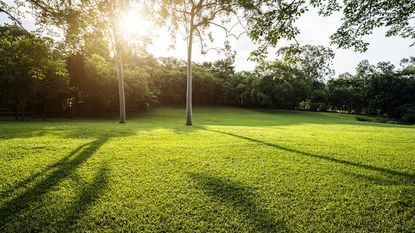Chemical Free Lawn Care Tips


Growing up in the burbs, a lush lawn was as much a hallmark of success as a shiny, new car in the driveway. My family diligently sprayed for weeds and pests. My father thatched and aerated yearly. Lime and chemical fertilizers were spread to create a thick carpet of turf grass. This idea of how to care for a lawn was perpetuated throughout the neighborhood as each family strove to have that picture-perfect lawn.
As an adult, I followed a different path in life. Moving out from the suburbs and purchasing acreage changed my ingrained principles of how to care for a lawn. Don't get me wrong. I still longed for that thick carpet of turf grass.
However, the cost of pesticides, herbicides and chemicals needed to treat acres of grass was prohibitive. Not to mention my concerns about the safety of using these products around my children, pets and wildlife. I needed a natural lawn care method, but realized I had to realign how I viewed my lawn in order for it to work.
Natural Lawn Care
When we look at how to care for a lawn, I find we often think in terms of chores. The lawn needs to be mowed and fertilized. The weeds need eliminating. But natural lawn care is not about chores. It's about the cultivation of plants. And as gardeners, we all know the success of growing fruits, vegetables and flowers is dependent upon planting, fertilizing and pruning at the correct time.
Why shouldn't our lawns be treated the same way? For example, the grass doesn't need to be cut as much as the individual grass plants need to be pruned. Taking the tops off the grass leaves promotes tillering, which is the production of side shoots. The key to having a lush lawn of thick grass is knowing how to care for those individual plants!
Lawn Care Tips
When we view our lawns as being made up of individual plants, we start to understand the damage and stress we put on our turf-grass from improper care. If you'd like to ditch the chemicals, try these lawn care tips to promote a green, lush lawn:
- Mowing - Remember, you're pruning the grass to promote tillering. Removing more than 1/3 of the leaf length and mowing in the heat of the day stresses the grass plants. Avoid cutting wet grass and keep mower blades sharp to prevent excess damage to the grass leaves. Mow at a height of 3 to 4 inches (7.6 to 10 cm.) to encourage deeper roots which keeps grass greener during dry spells.
- Weeding - A taller, thicker lawn crowds out many types of weeds. Reseed bare spots, hand-pull the occasional weed, or spot treat with boiling water or vinegar. When the lawn is weedy, bag and compost clippings. Dispersing weed seeds and pieces of self-rooting vining weeds only adds to the problem. "¢
- Fertilizing - Top dress the lawn with compost or use an organic fertilizer. Fall is the best time to apply fertilizer as it helps prepare the lawn for winter. If the lawn is weed-free, dispersing grass clippings returns nutrients back to the yard. Clippings should be less than one inch (2.5 cm.) in length and evenly distributed to avoid smothering areas in the lawn.
Gardening tips, videos, info and more delivered right to your inbox!
Sign up for the Gardening Know How newsletter today and receive a free download of our most popular eBook "How to Grow Delicious Tomatoes."

Laura Miller has been gardening all her life. Holding a degree in Biology, Nutrition, and Agriculture, Laura's area of expertise is vegetables, herbs, and all things edible. She lives in Ohio.
-
 Clever Vertical Vegetable Garden Ideas For Small Spaces – 7 Ways To Save Space
Clever Vertical Vegetable Garden Ideas For Small Spaces – 7 Ways To Save SpaceShort on garden space? Learn some vegetable garden ideas for small spaces that are fun and easy.
By Mary Ellen Ellis
-
 26 Different Types Of Orchids – With Pictures & Information
26 Different Types Of Orchids – With Pictures & InformationDiscover stunning orchid types to grow in your home and garden – from easy beginner varieties to rare and exotic species that are the preserve of experts.
By Melanie Griffiths